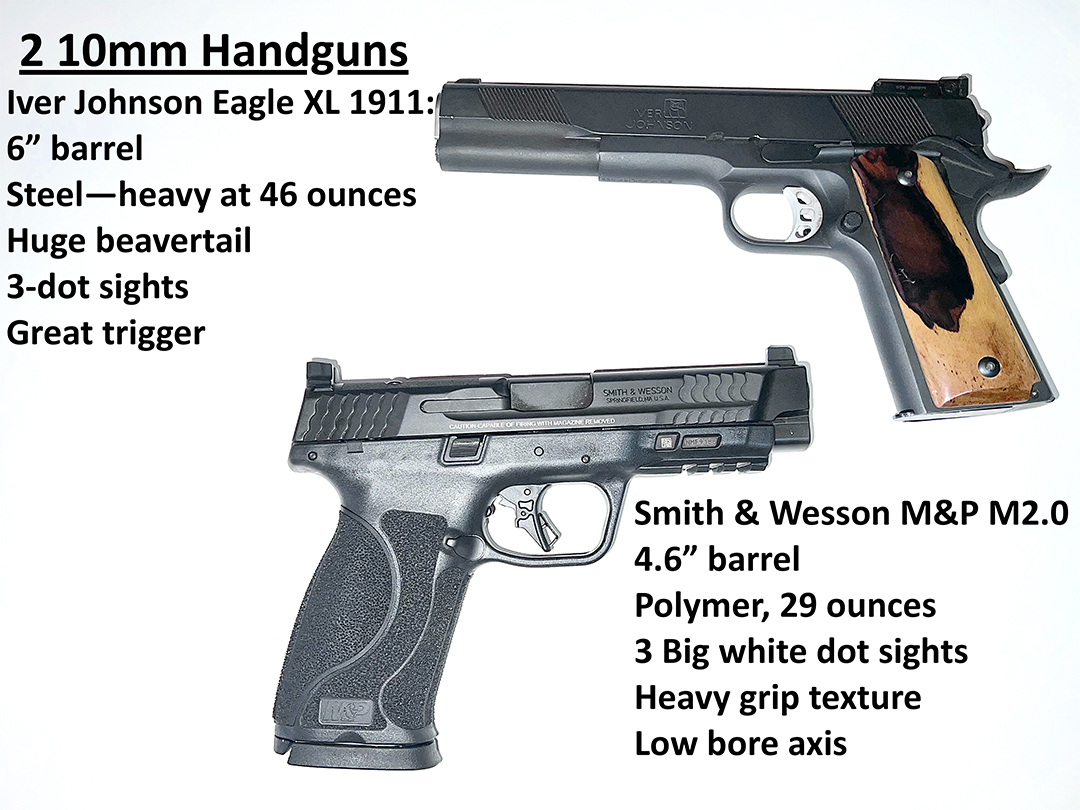10mm: S&W M&P 2.0 or Iver Johnson Eagle XL?

By MARJ LAW

Which is better: a striker-fired or a hammer-fired handgun?
A long or a longer barrel?
Today, Joe and our friend Rick will be comparing two 10mm handguns: the striker-fired Smith & Wesson M&P 2.0 and the hammer-fired Iver Johnson Eagle XL 1911.
You know that Joe is not-too-secretly rooting for the Iver. He still, in his heart, prefers the 1911s he trained with during his stint in the Navy.
“You can’t beat a 1911 trigger,” he pronounces.
However, in a somewhat half-hearted attempt to sound fair he adds: “The proof is in the operation.”
He has to have some give here because a couple years ago, Santa Claus brought him to the dark side by presenting him with a striker-fired Sig Sauer P320. He likes it. A lot.
He says of the Sig: “The grip is very good. It’s quite accurate. The trigger is smooth,” he begins, and I know what’s coming.
“It’s not quite a 1911 trigger, but it’s good.”
High praise from a 1911 fan. So, I expect he’s going to favor that 1911 Iver Johnson hammer gun over the striker-fired Smith. Let’s see.
I am, though, afraid that my favored striker-fired Smith might lose out here because it has a 4.6-inch barrel and the Iver has a 6-inch barrel. That’s quite a difference, and I think that almost inch-and-a-half will give Iver the edge.
Iver is heavier. A lot heavier. You’d wonder at this because Iver holds 8 rounds while Smith holds a whopping 15 rounds. But Iver is made of steel and Smith has a polymer frame. Steel is heavy. Iver weighs in at 46 ounces and Smith at 29 ounces.
Accuracy?
While you might find carrying Smith a lot easier because it’s so much lighter, you might prefer Iver because its solid heaviness sits deeply in your hands and helps prevent muzzle rise. That’s so good for accuracy.
Both guns have two white dot sights in the rear and 1 in the front. Sights on the Smith are a lot larger. I like big fat white dot sights.
Smith comes with four different backstraps to conform the grip into your hand. And texture? Stippling on the grip is really high. No amount of Florida sweat is going to slip this grip from your hands.
Tyler Freel, writing in Outdoor Life, says of the Smith: “Shooting a 10mm well has everything to do with recoil management. The factory profile and texturing of the grip on this pistol do an excellent job facilitating a secure grip. The smooth rounded contour of the front of the grip and relatively thin trigger guard allowed for a close-to-bore-axis, tight grip. Recoil on 10mm pistols is sharp, and a comfortable solid grip aids with speed, accuracy, and confidence.”
He goes on to add: “it was the most comfortable un-modified 10mm that I’ve shot.”
Iver’s grips? Well, we found a site called Esmerelda on the internet. She has some of the prettiest grips you’ve ever seen. Iver now sports Desert Ironwood grips. They’re smooth and gorgeous. Does the smoothness mean your hands will slip? Not with the weight of this gun!
A few years ago, I was in the Wakulla County Sheriff’s range office and heard, Blam! I jumped! What is that awful racket? Opening the door, I saw Joe shooting the Iver. Blam! He shot again. Horrors. He’s going to want me to shoot that 10mm monster!
Sure enough. “Marj, ready to shoot this gun?”
Drat. Iver’s weight settled in my hand. I adjusted my earplugs and ear muffs (wearing both), take a breath, let it out, and take aim.
Blam! Lots of noise, but the gun stays nicely in my hands. Shockingly easy. That’s why I’m surprised when Joe takes out the Lyman scale to measure trigger pull and comes up with 7 pounds, 12 ounces. It feels so much less.
The Smith’s trigger pull comes out to 5 pounds, 11 ounces.
“The Iver has that great 1911 trigger.” I just knew Joe was going to say that. But I have to admit that the Smith, though having a lighter trigger pull, travels squishily all the way to the wall. Then it breaks with an easy crack.
Jon Wayne Taylor, writing of the Smith, says: “I was interested, but didn’t think I would be impressed. I was wrong.” He adds: “It fits the hand well, and soaks up recoil for fast follow-up shots with the heaviest loads…
“How much do I like this gun? I sold my Delta Elite and bought this T&E model instead. It’s certainly my favorite of the polymer framed 10s.”
Dr. John Woods, in All Outdoor says of the Iver: “The Eagle XL has one of the easiest slide cycles I have ever experienced. It was smooth, even, and easy to manipulate.
It would be an imposing defensive weapon… Shooting at 10 feet, the accuracy was exceptional in my opinion. This is one fine shooting 1911. It is definitely a keeper.”
Now Joe and Rick are going to a range. I am particularly interested in hearing how these 2 guns handle light and heavier loads. We bring 180 and 200-grain 10mm loads and will shoot two rounds of each for handleability and accuracy.
Rick shoots the Smith with 180-grain loads first.
“Wow. The grip texture is pretty strong!” he notes right away.
Bang! Bang! The report is loud. Rick’s shots hit the small metal target from 35 yards away. He walks back to us, grinning.
“Smooth! Accurate!” he says. “But it does have a pretty strong kick! On a scale of 1-5, with 1 being the lightest kick and 5 the worst kick, I’d give recoil on the Smith a solid 3. My palm’s a little pink from the stippling and the recoil.
“I’d give the trigger a 2 out of a possible 5. It’s fairly light. But there’s some travel. I’d give travel a 3.
“The slide is still pretty stiff. Guess it’s partly because the gun is new. I’ll give jacking the slide a 3.5.”
He shoots the 200-grain load next.
“Who-ee! That thing comes back at you! With the heavier load, I’ll give the kick a 4 out of a possible 5.” His hand is even pinker now.
Joe says that’s because of the low bore axis of the barrel, which makes the gun come straight back at you.
He shoots next. Joe finds the recoil to be considerably less and gives it a 1.5. He had shot the gun a bit earlier and is prepared for the recoil.
Then he shoots the heavier 200-grain load. Joe is feeling a lot more recoil with this load and gives recoil a 3.5 as opposed to Rick’s 4. With this heavy load, both guys agree that the Smith has a very sturdy kick.
Iver is next, and Rick shoots the 180-grain rounds in it.
Bang!
“Nice!” he exclaims happily. He finds trigger pull and travel to be quite short and gives both a 1.5. He finds the recoil to be light as well, and gives a 2 for kick.
Joe shoots the 180-grain load. He gives trigger pull a 1.5 and travel a 1. He figures the kick at a 1.
Later, Joe shoots the 200-grain rounds and gives the Iver a 2.5 for recoil. Clearly, in both the Smith and the Iver, there’s a lot of difference in shooting the heavier load over the 180-grain target load.
“If the gun fairy drops down out of the sky and says you get to keep one of these guns, which would it be?” I ask Joe.
“If I were going hunting, I’d take Iver. The longer barrel imparts more energy to the round. It has a higher bore axis for more muzzle flip, but the weight of the gun holds it quite steady. I like the feel of the gun in my hand.
On the other hand, if I were to carry one of these 2 guns, I’d carry the Smith. It’s a whole lot lighter and shorter to make it easier to carry. It holds 15 rounds, which is a lot more than Iver’s 8 rounds. The bigger white dot sights make it easier to align them to the target. For carry, I’d take the Smith.”
It’s quite clear to me.
Joe wants both guns.
Marj Law is the former director of Keep Wakulla County Beautiful who has become an avid shooter in retirement.
